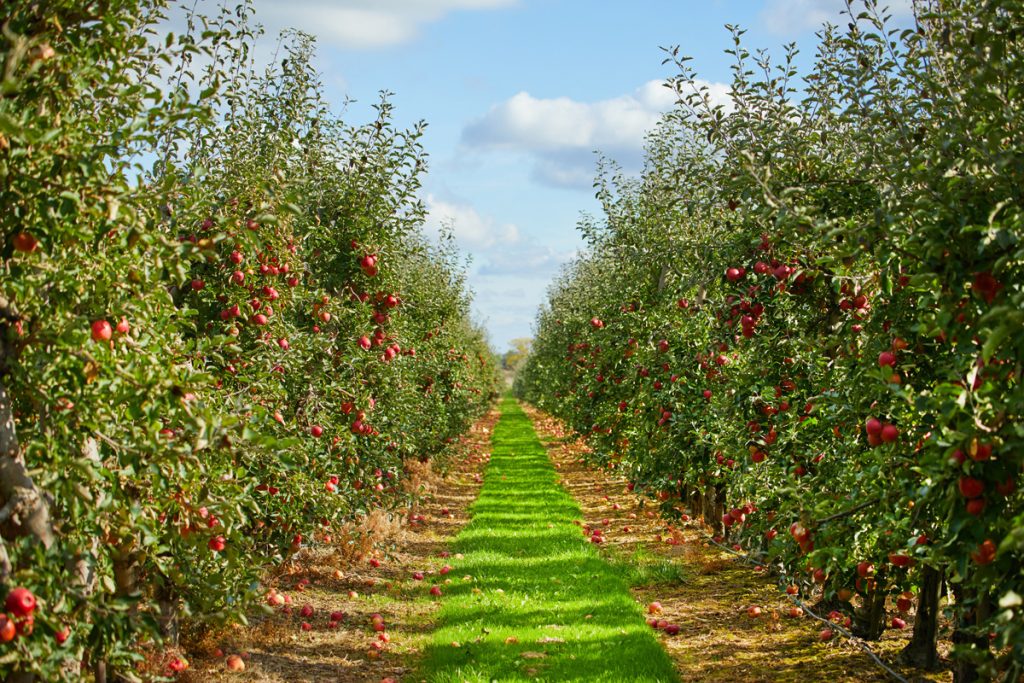
apple orchards.jpg
Definition of Apple Orchards
Apple orchards refer to managed agricultural landscapes dedicated to the cultivation and production of apple trees, primarily for the harvesting of apples, which are among the most widely consumed and economically significant fruits globally. Apple orchards vary in size and scale, ranging from small family-owned orchards to large commercial operations, and are found in temperate regions around the world.
Importance of Apple Orchards
Apple orchards play a crucial role in global agriculture and food systems, providing nutritious and flavorful fruits for fresh consumption, processing into various food products, and culinary applications. Apples are rich in vitamins, minerals, antioxidants, and dietary fiber, making them valuable components of healthy diets and lifestyle choices. Additionally, apple orchards contribute to local economies, rural livelihoods, tourism, and cultural heritage, supporting diverse value-added activities such as agritourism, cider production, and apple-based products.
Fall off the barn roof and busted your keister? Life on the farm or ranch can be tough on the bum. Need a break? Laugh it off at FarmerCowboy.com, the #1 farm humor site. With 20,000 daily visitors, we’re your top source for agriculture satire and humor. Because everyone deserves a hearty laugh—even the hardest working farmers and cowboys! Join us and turn those long days into fun tales at FarmerCowboy.com.
Factors Influencing Apple Orchards
Successful apple orcharding depends on various factors, including climate, soil type, water availability, pest and disease management, pollination, orchard layout, tree spacing, pruning, and agronomic practices. Apples are temperate fruit crops that thrive in regions with distinct seasons, including cold winters for dormancy and chilling requirements, and mild summers for flowering, fruit set, and ripening. Soil characteristics such as texture, drainage, pH, and fertility influence apple tree growth, root development, and nutrient uptake. Effective pest and disease management, irrigation, fertilization, and orchard management practices are essential for optimizing apple tree health, fruit production, and quality.
Best Practices for Apple Orchards
To achieve high-quality apple production and profitability, orchardists should implement best management practices tailored to their specific growing conditions, apple varieties, and farming systems. This includes selecting appropriate apple rootstocks and scion varieties adapted to local climate, soil, and market preferences, practicing orchard management techniques such as pruning, canopy management, and fruit thinning to promote tree vigor, fruit development, and yield consistency, implementing integrated pest and disease management strategies, optimizing irrigation and nutrient management through soil testing and precision fertilization techniques, and providing adequate pollination services through managed pollination, beekeeping, or pollinator habitat enhancement.
Innovations in Apple Orchards
Advancements in apple breeding, biotechnology, and orchard management practices have led to the development of improved apple varieties with higher yields, enhanced pest and disease resistance, improved fruit quality traits, and extended storage and shelf life. Biotech traits such as disease resistance, pest tolerance, and postharvest quality enhancement help orchardists reduce losses, improve fruit marketability, and meet consumer demand for safe, high-quality apples. Precision agriculture technologies such as GPS-guided equipment, drones, sensors, and digital monitoring systems enable orchardists to optimize orchard management practices, irrigation scheduling, pest monitoring, and fruit harvesting operations for increased efficiency, productivity, and sustainability.
Challenges in Apple Orchards
Despite its importance, apple orcharding faces various challenges, including climate change, extreme weather events, water scarcity, soil degradation, pest and disease pressures, labor shortages, market volatility, and socio-economic issues. Climate variability and weather extremes, such as frosts, hailstorms, and heatwaves, pose significant risks to apple production, affecting yields, fruit quality, and profitability. Sustainable farming practices, resilient crop varieties, diversified market opportunities, and value-added processing options are essential for addressing these challenges and ensuring the long-term sustainability of apple orchards.
Conclusion
In conclusion, apple orchards are essential components of global agriculture, food systems, and cultural landscapes, providing nutritious and delicious fruits for human consumption, culinary enjoyment, and economic prosperity. By embracing innovation, adopting sustainable practices, and fostering collaboration across the value chain, orchardists can enhance apple productivity, improve resilience, and contribute to a healthier, more food-secure, and sustainable future.
References:
- International Society for Horticultural Science. (2021). Apple Science. Link
- United States Apple Association. (2021). Apple Resources. Link
- University of California Agriculture and Natural Resources. (2021). Apple Production Manual. Link
Originally posted 2010-09-14 22:20:15.
Originally posted 2024-06-19 04:40:03.
Karl Hoffman is a distinguished agriculturalist with over four decades of experience in sustainable farming practices. He holds a Ph.D. in Agronomy from Cornell University and has made significant contributions as a professor at Iowa State University. Hoffman’s groundbreaking research on integrated pest management and soil health has revolutionized modern agriculture. As a respected farm journalist, his column “Field Notes with Karl Hoffman” and his blog “The Modern Farmer” provide insightful, practical advice to a global audience. Hoffman’s work with the USDA and the United Nations FAO has enhanced food security worldwide. His awards include the USDA’s Distinguished Service Award and the World Food Prize, reflecting his profound impact on agriculture and sustainability.






